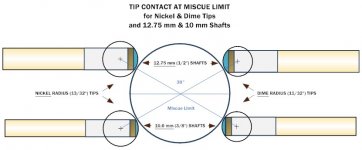The ferrules I have are the "sleeve" type, which I worry about cracking (even though it has only happened once in more than ten years).What are you unhappy with your current shaft that you want your next one to have no ferrule? No ferrule reduces weight, which reduces squirt, I assume, but are there any other advantages? Are there any drawbacks?
The "sleeve" ferrules I have now limit the diameter of the hollow core (because some wood "wall" needs to be left to glue the ferrule to). Also, I think it might help prevent the wood from mushrooming without a sleeve ferrule.Bob Jewett hasn't replied to this yet, but why do you think a pad might be better?
It's only about 3/16 inch in diameter - I think it could be a little bigger without the "sleeve" ferrule.How large is the hollowing in your current 10mm shaft (diameter and depth)? Would you also do this with the ferrule less cue to further reduce squirt?
My shafts are actually 9.5mm - I feel they could be even smaller without risking damage from just playing. There's probably a limit but I don't know what it is.Would you go any smaller than 10mm? I assume it's still just preference, but is there a limit at which small is too small to play pool with?
I jump and masse with my 9.5mm tips - no problem (except I jump like a white guy). I don't know how small is too small.Yu said you don't break with these shafts (I would assume out of risk of damage), what is the smallest diameter shaft you could hit the hardest non-break/jump/masse shot in pool without risk of damage in your mind? Bob mentioned seeing a 6mm shaft -- is that too small?
pj
chgo
